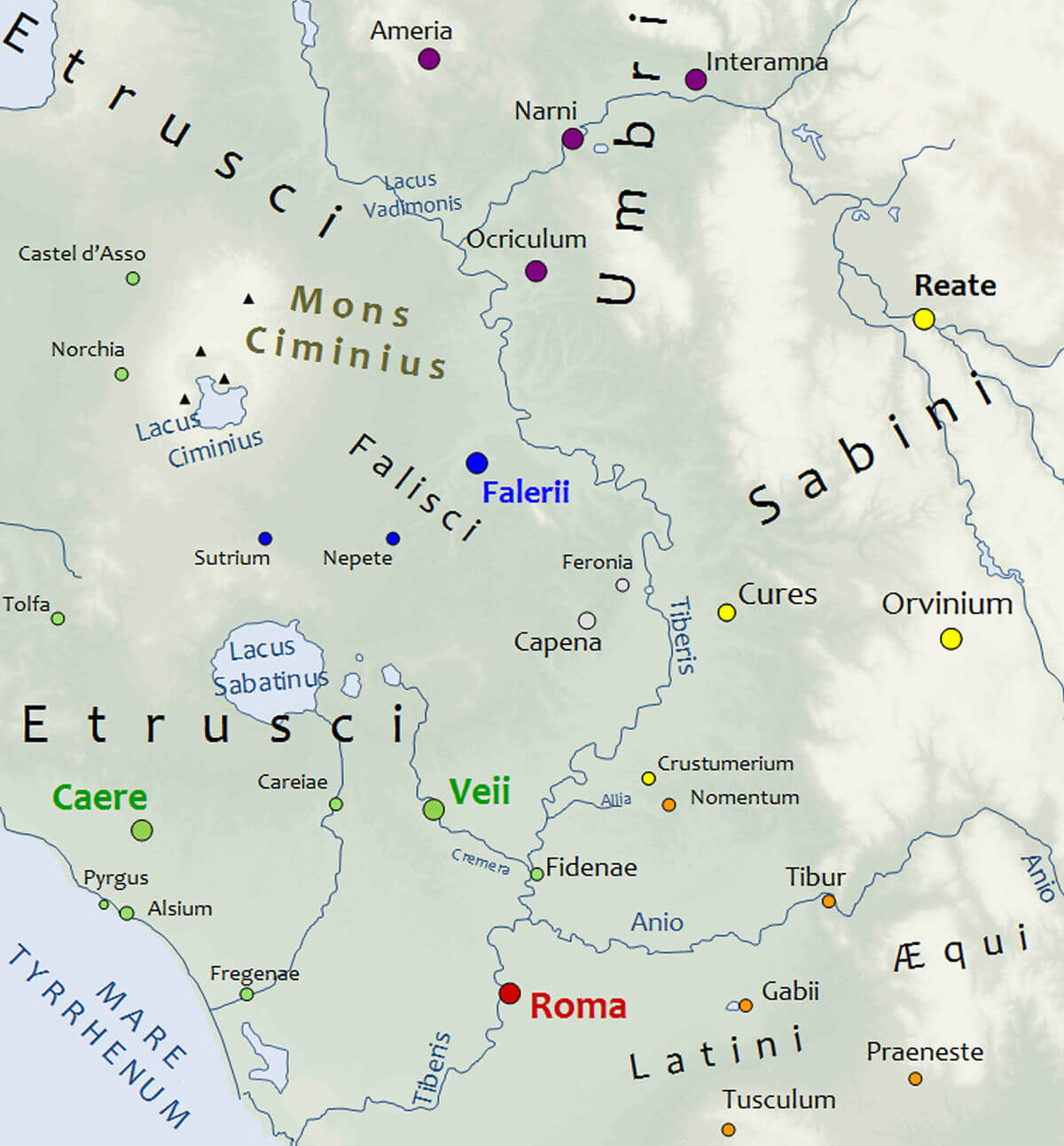Despite removing the yoke of Etruscan rule in the late 6th century BC, the Etruscans would remain a viable threat to the fledgling Roman Republic for another three centuries. The Etruscan city-state of Veii was situated only 12 miles to the north of Rome and, being equally matched in strength, was the main source of concern.

ColdEel & Ahenobarbus, CC BY-SA 3.0, via Wikimedia Commons
A map showing Veii, Rome and the surrounding region in 450 BC
Between Rome and Veii ran the important transportation and commerce artery, the Tiber River. Control of it was vital to both cities, and conflict was inevitable. The city controlling access to the Tiber also controlled access to Western Italy, Latium, Samnium, Etruria, and partly northern Campania. The town of Ostia, settled on the mouth of the Tiber and the Mare Tyrrhenum, was also a vital source of salt, and access to its mines were of utmost importance to both cities.
Such vital economic repercussions in a considerably small area led to many conflicts over time. As such, in the early 5th century BC, a powerful Roman familia, the Fabians, had settled into Etruscan territory near the town of Fidenae. With the risk of potential damage to the Etruscan economy, raids on both sides soon escalated led to war.
While the history of the events that followed is based on legend (and suspiciously similar to the Peloponnesian battle of Thermopylae), it was said that the Veientanes destroyed 300 Fabii at the Battle of the Cremera, leaving all but one dead.
Within a year of the victory at the Cremera, the Etruscan navy - in conflict with Greece - was destroyed by Hieron of Syracuse, off of Cumae. The result was a military disaster for the Etruscans that they never really seemed to recover from. The various city states of the Etruscan league, including Veii, devolved more and more into separate unrelated entities, thereby losing the strength of mutual protection. Veii, despite its recent upper hand at Cremera, was forced to make a treaty with Rome.
Within this timeframe, a more consequential series of events were taking place, however. Celtic Gauls had been migrating into northern Italy from the 6th century BC, and establishing themselves at or near Etruscan territory. Raids and warfare with these people would have a debilitating effect on the Etruscans, and play directly into the growing strength of Rome. The Gauls so weakened the Etruscans that the Romans, between 406 and 396 BC, went on the offensive.
It's around this period in history that Livy tells us of the legendary Roman hero Marcus Furius Camillus. Under his command, Fidemae was retaken from Veii, and then the city of Veii itself came under siege. According to the legend, the Siege of Veii lasted 10 years, but its description is so closely paralleled to the Homeric Siege of Troy, that we must take into account the propaganda used by ancient sources to inflate the glory of Rome.
The actual siege probably lasted considerably less time, though the introduction of a paid professional legion during this course of events indicates that it was a protracted campaign. The siege was finally broken, in 396 BC, when the Romans supposedly drained Alban Lake. This would not only divert water supplies from the city, but allowed access for Roman soldiers to sneak under the walls through the empty stream beds.
In the end, whatever the truth behind the legend may be, Camillus was credited with saving Rome, and bestowed with the unending admiration of the Romans throughout their history.
Gaining Veii, the Romans - in stark contrast to their general conquest policies of incorporation - destroyed much of the city and drove out many of the Etruscan residents. The territory was allotted to Roman citizens, and four new tribes were created: the Stellatine, Tromentina, Sabatina and Aniensis.
Veii's capture resulted in a considerable increase in Roman territory and strength. As a result, the Roman state - which had already been a match for the Latin league in its entirety - was now greatly predominant in resources and manpower over her divided neighbors.
Slowly, over the course of the next century, the Etruscan cities would be added to the Roman fold one by one. In various forms over this time, they would side with Rome's enemies in desperate attempts to break their hold on power in central Italy.
The decline of the Etruscan people, however, with regards to their power in the region, was inevitable by this point. Their lack of unity and cooperation, despite joining various enemies of Rome in the waning years of Italian independence, led directly to their own demise. By 273 BC, Etruria and the Etruscans would be completely within the domain of Rome.
Roman Conquest of Italy - Table of Contents
- Introduction
- Veii and the Etruscans
- The Gallic Sack of Rome
- The Samnite Wars
- The Latin Revolt and the End of the Latin League
- The Pyrrhic War
Did you know...
Etruria wasn't colonized by the Phoenicians or Greeks, unlike Southern Italy. However, the Etruscan culture was heavily influenced by the Greeks. They adopted Greek customs, like the symposium, literacy, epic poetry, and the ownership of finely crafted luxury items.



